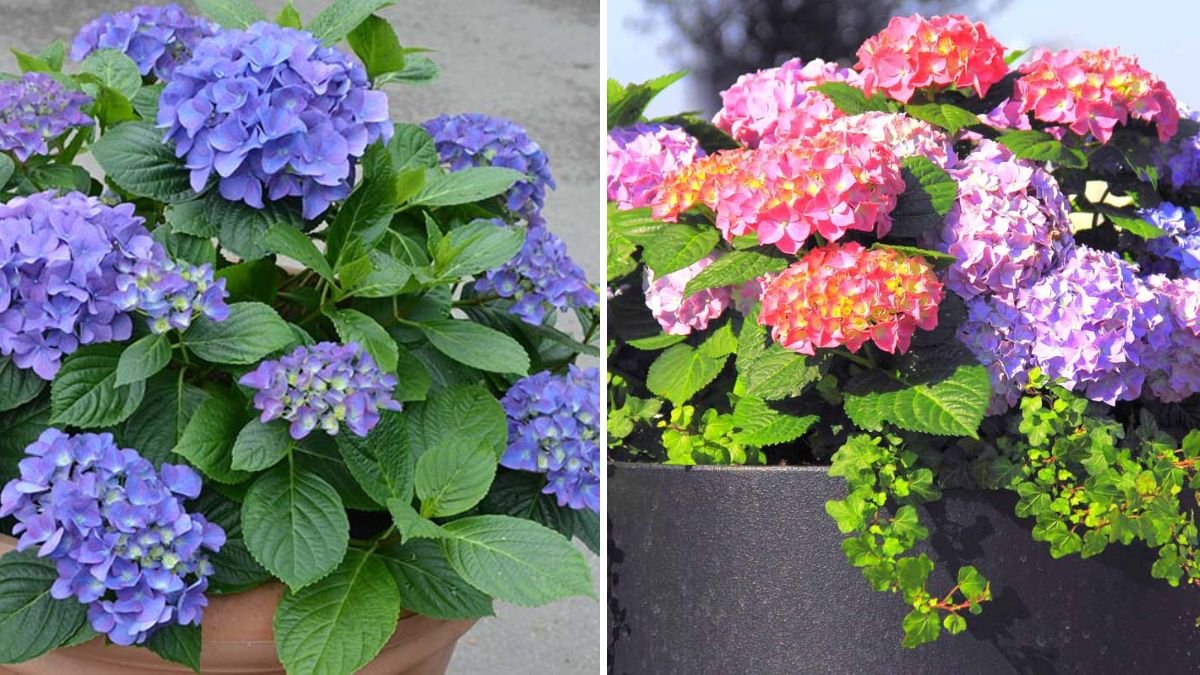Hydrangeas (Hydrangea macrophylla) are among the most popular flowering shrubs for gardens, known for their large, lush blooms and vibrant colors. While hydrangeas can display a range of hues from pink to purple to blue, achieving deep blue flowers requires specific soil conditions, careful plant care, and proper seasonal management. Deep blue hydrangea blooms are highly prized for their striking appearance and long-lasting floral display, making them a favorite for both garden beds and container arrangements.
This article provides a comprehensive guide on how to grow hydrangeas with deep blue flowers, covering soil management, fertilization, pruning, watering, and seasonal considerations.
1. Understanding Flower Color in Hydrangeas
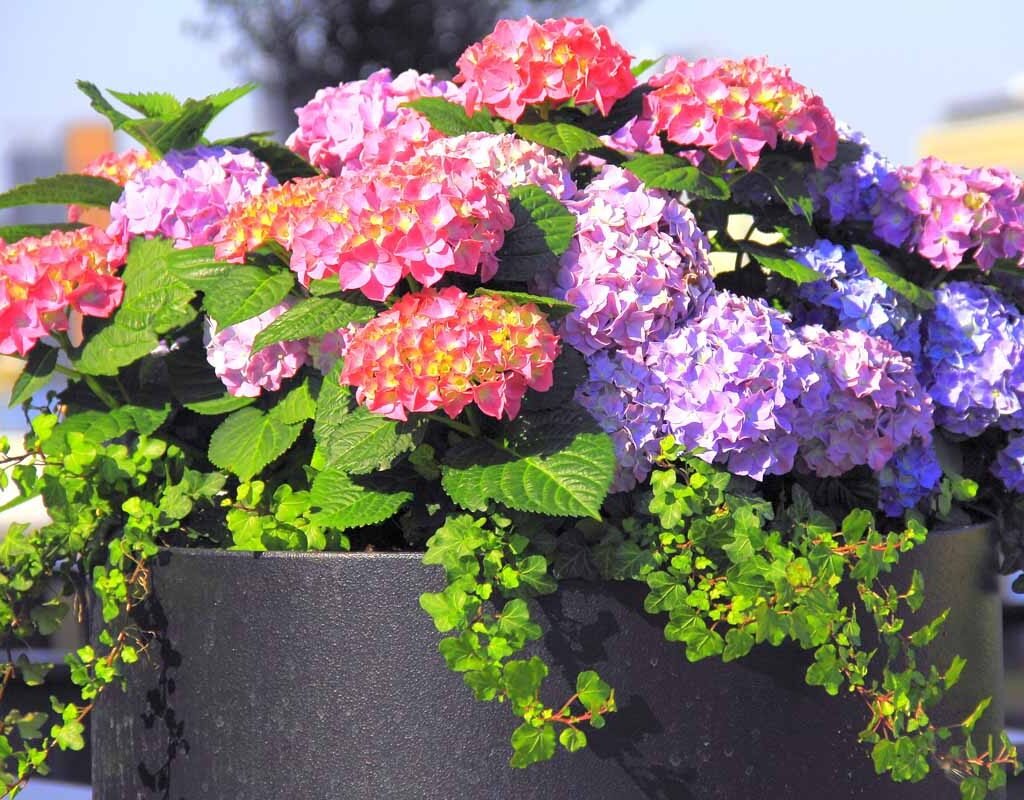
Hydrangea flower color is primarily determined by soil pH and aluminum availability:
- Acidic Soil (pH 5.2–5.5): Promotes blue blooms.
- Neutral to Alkaline Soil (pH 6.5+): Produces pink or purple blooms.
- Aluminum Availability: Essential for blue pigmentation; aluminum is more accessible in acidic soils.
Understanding the relationship between soil chemistry and flower color is crucial for cultivating deep blue hydrangeas.
2. Selecting the Right Hydrangea Varieties
Not all hydrangeas can produce true blue flowers. Choose varieties known for their blue color potential:
- Bigleaf Hydrangeas (Hydrangea macrophylla): Most responsive to soil pH changes.
- Blue-Flowered Cultivars: ‘Nikko Blue,’ ‘Endless Summer Blue,’ ‘Blue Wave,’ and ‘Bluebird.’
- Climbing Varieties: Some climbing hydrangeas may show blue hues under acidic conditions.
Selecting the right variety ensures maximum potential for deep blue blooms.
3. Soil Preparation for Deep Blue Blooms
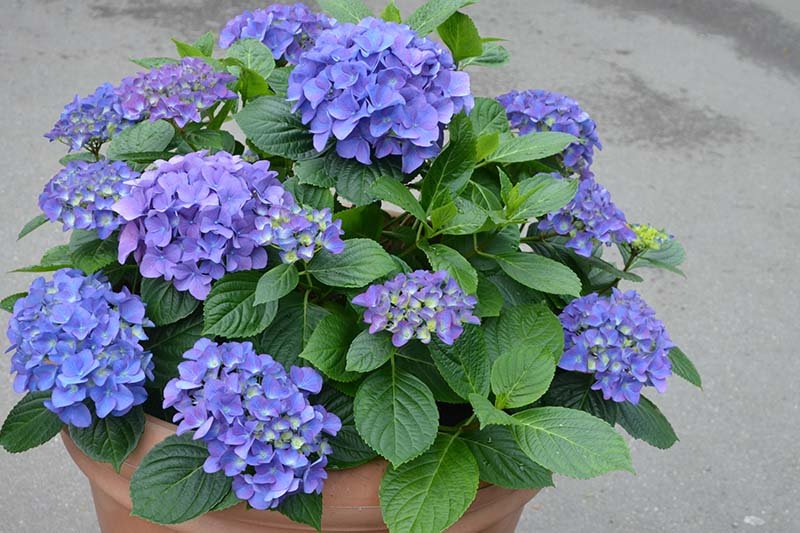
Soil preparation is key to achieving and maintaining blue flowers:
- Acidic Soil: Aim for a pH between 5.2 and 5.5.
- Amending Soil: Use sulfur, peat moss, or acidic compost to lower pH.
- Aluminum Supplementation: Garden aluminum sulfate or commercially available hydrangea blue fertilizers increase aluminum availability.
- Soil Testing: Regular testing ensures pH and nutrient levels are suitable.
- Drainage: Well-draining soil prevents root rot while maintaining moisture.
Proper soil preparation provides the chemical environment needed for deep blue flowers.
4. Planting Hydrangeas
Planting hydrangeas correctly ensures healthy growth and abundant blooms:
- Timing: Plant in spring or fall for optimal root establishment.
- Spacing: 3–5 feet apart to allow airflow and reduce disease risk.
- Depth: Plant at the same depth as in the nursery container to avoid stress.
- Mulching: Apply a 2–3 inch layer of mulch to retain moisture and regulate soil temperature.
Correct planting creates a strong foundation for robust flowering.
5. Watering Practices
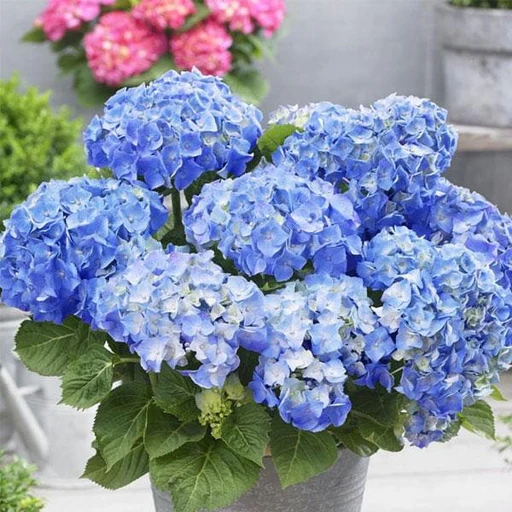
Hydrangeas require consistent moisture to maintain large, healthy blooms:
- Frequency: Water deeply 2–3 times per week, more during hot or dry conditions.
- Morning Watering: Reduces fungal risk and ensures moisture absorption.
- Avoid Overhead Watering: Wet leaves can promote disease; use drip irrigation if possible.
- Container Hydrangeas: Monitor closely, as pots dry faster than garden beds.
Proper watering supports vigorous growth and consistent flower production.
6. Fertilization for Blue Flowers
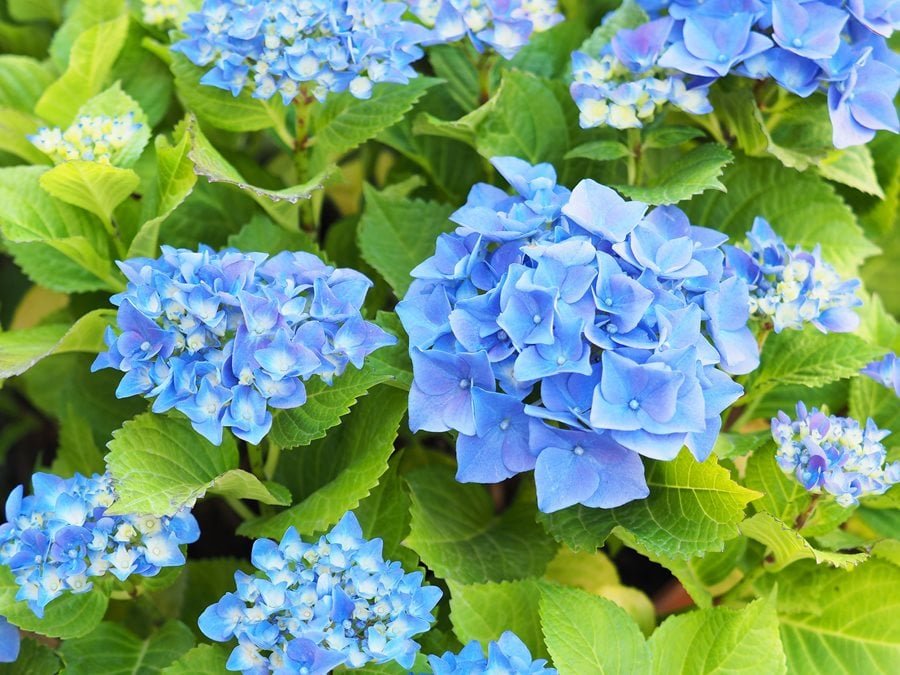
Balanced nutrition encourages strong plants and vibrant flower color:
- Phosphorus Limitation: Excess phosphorus can inhibit aluminum uptake, reducing blue coloration.
- Potassium and Nitrogen: Essential for healthy foliage and flower size.
- Specialized Fertilizers: Use fertilizers labeled for blue hydrangeas or acid-loving plants.
- Application Timing: Fertilize in early spring and mid-summer to support growth and blooming.
Fertilization ensures healthy plants with deeply pigmented blooms.
7. Maintaining Acidic Conditions
Maintaining low soil pH is crucial for blue hydrangeas:
- Regular Soil Testing: Monitor pH every 6–8 weeks during the growing season.
- Aluminum Supplementation: Apply aluminum sulfate in small, repeated doses to prevent toxicity.
- Acidic Mulch: Pine needles or shredded oak leaves help maintain soil acidity.
- Avoid Lime: Do not use lime or alkaline fertilizers, as they shift blooms toward pink.
Consistent acidity promotes intense, deep blue coloration in flowers.
8. Pruning and Deadheading
Proper pruning enhances bloom quality and longevity:
- Timing: Prune after flowering for bigleaf hydrangeas, as they bloom on old wood.
- Deadheading: Remove spent blooms to encourage new bud formation.
- Shape Maintenance: Trim leggy branches to maintain a compact and healthy shrub.
- Avoid Heavy Winter Pruning: Can reduce blooms the following season.
Pruning supports strong, vibrant flowers and bushy growth.
9. Sunlight Requirements
Hydrangeas need balanced sunlight to produce large, healthy blooms:
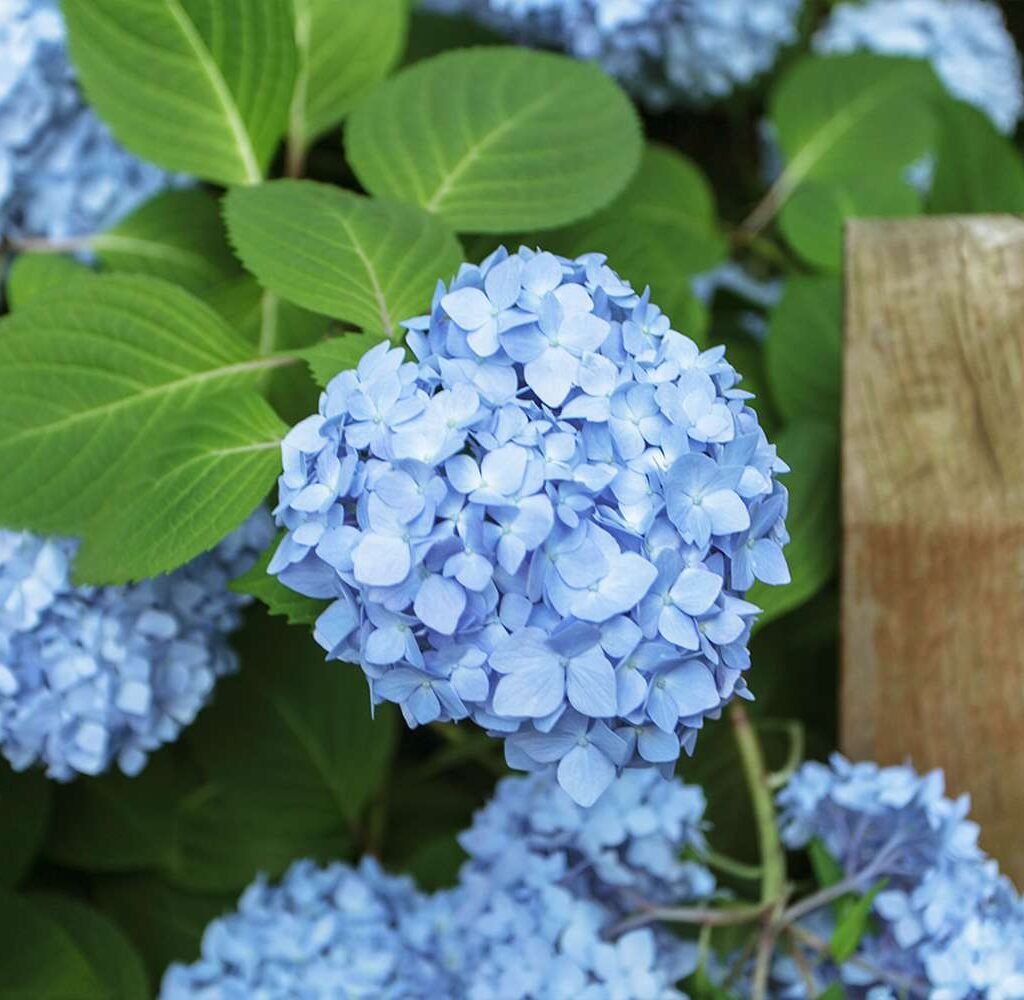
- Partial Shade: 4–6 hours of morning sun is ideal.
- Avoid Harsh Afternoon Sun: Can scorch leaves and reduce flower longevity.
- Filtered Sunlight: Protects delicate blooms while supporting photosynthesis.
Proper sunlight ensures healthy foliage and well-formed flower heads.
10. Pest and Disease Management
Hydrangeas are susceptible to common fungal and insect pests, especially in moist conditions:
- Powdery Mildew and Leaf Spot: Ensure good airflow and avoid overhead watering.
- Aphids and Spider Mites: Monitor regularly and use organic treatments like neem oil if necessary.
- Root Rot: Prevent waterlogged soil conditions.
- Sanitation: Remove fallen leaves and debris to reduce pathogen presence.
Healthy, well-maintained plants are less prone to disease and consistently produce deep blue blooms.
11. Seasonal Care for Winter and Summer
Adjust care based on seasonal changes:
- Spring: Test soil pH, apply fertilizers, and prune dead branches.
- Summer: Maintain consistent watering, mulching, and aluminum supplementation.
- Autumn: Reduce fertilizer, prepare soil for winter, and mulch heavily to protect roots.
- Winter: Avoid pruning frozen branches; provide frost protection if necessary.
Seasonal care ensures continuous growth and flower quality throughout the year.
12. Container-Grown Blue Hydrangeas
For smaller spaces or patios, containers can support hydrangeas:
- Pot Selection: Choose large pots (minimum 15–20 inches) with good drainage.
- Soil Mix: Use acidified potting mix with peat moss and perlite.
- Watering: Containers dry faster, requiring more frequent moisture monitoring.
- Fertilization: Apply liquid or slow-release fertilizers suited for acid-loving plants.
Container hydrangeas can produce deep blue flowers similar to garden-grown plants when cared for properly.
13. Troubleshooting Flower Color Issues
Several factors can prevent blue blooms:
- Soil Too Alkaline: Use sulfur or acidic amendments to lower pH.
- Aluminum Deficiency: Add aluminum sulfate carefully.
- Excess Phosphorus: Avoid phosphorus-heavy fertilizers.
- Improper Pruning: Cutting old wood can remove future flower buds.
Understanding these factors helps gardeners maintain deep blue coloration season after season.
14. Benefits of Deep Blue Hydrangeas
Cultivating blue hydrangeas provides multiple rewards:
- Aesthetic Appeal: Striking blooms create visual focal points in gardens.
- Long-Lasting Flowers: Proper care ensures extended bloom periods.
- Versatility: Suitable for beds, borders, and containers.
- Pollinator Support: Hydrangeas provide nectar for bees and other pollinators.
- Personal Satisfaction: Achieving true blue blooms is a fulfilling accomplishment for gardeners.
Deep blue hydrangeas elevate garden beauty and visual interest.
Conclusion
Growing hydrangeas with deep blue flowers requires careful attention to soil acidity, aluminum availability, and proper plant care practices. Selecting the right variety, preparing acidic soil, providing balanced fertilization, maintaining consistent moisture, and following seasonal pruning strategies all contribute to healthy, vibrant, long-lasting blooms. By combining proper sunlight, pest management, and container or garden bed techniques, gardeners can enjoy stunning blue hydrangea displays that enhance the beauty of any outdoor or patio space. With dedication and knowledge, achieving deep blue hydrangea flowers is both rewarding and sustainable.
